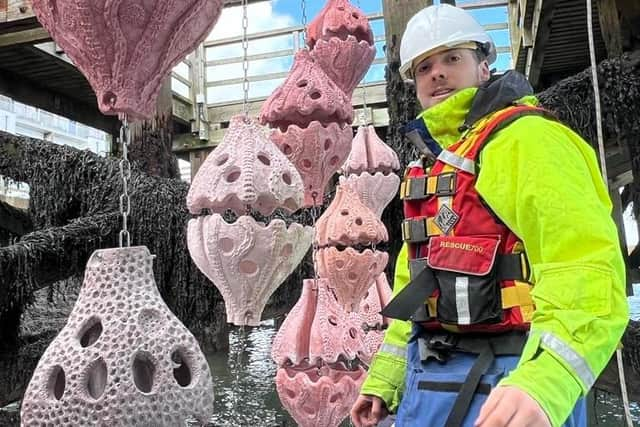Artificial shelter shells installed at Commissioner’s Quay in Blyth to improve marine biodiversity
and live on Freeview channel 276
57 hanging ‘shelter shells’ will be deployed, the largest installation of its kind in the world, to encourage animal and plant life to live, feed, and rest in the area.
The project is part of the Revitalising our Estuaries programme run by community action charity Groundwork.
Advertisement
Hide AdAdvertisement
Hide AdHellen Hornby, from Groundwork, said: “We are excited to see this project finally coming to fruition. It has taken nearly three years from concept to installation.


“It is a major breakthrough to install a project of this size in one place and will provide a tremendous opportunity to measure the benefits of such artificial habitats to the wildlife of the Blyth estuary.
“A huge amount of planning and preparation goes into these projects from landowner and stakeholder engagement, survey work, licensing, and permissions to the installation and monitoring.
“We cannot wait to see the results of our joint efforts and will be monitoring the site over the coming year.”
Advertisement
Hide AdAdvertisement
Hide AdThe shell-shaped, custom-moulded, concrete structures weigh 12kg each and will be suspended in pairs on a central chain.
Shells are textured to replicate naturally-occurring surfaces and differently coloured to attract a variety of marine life. They have holes to allow fish to swim through and artificially create rock pools when the tide drops below them.
They will be suspended together from wooden beams and will be visible to the public at low tide.
Hellen added: “The aim is to use nature to tackle some of the impacts of industrial damage on our natural habitats.
Advertisement
Hide AdAdvertisement
Hide Ad“By creating artificial intertidal and estuarine habitats here in Blyth, we hope to encourage the return of marine life and improve biodiversity and water quality, especially in waterways like this that have been impacted upon by years of industrial use.
“All these efforts are designed to offer some defence in the fight against climate change by increasing intertidal habitat, which is at risk due to sea level rises and coastal squeeze.”
The project has been financed by Environment Agency and government funds, with match funding from The Caterpillar Foundation and healthcare company Organon.
Heather Harrison, from the Environment Agency, said: “Nature is our biggest weapon in the fight against climate change and we are committed to this North East-wide programme to restore and revitalise our estuaries.
Advertisement
Hide AdAdvertisement
Hide Ad“The Revitalising our Estuaries programme has created opportunities to test projects of this sort and we hope the shelter shells project will be scaled up and rolled out across the world.
“We can proudly say that Blyth and the North East have led the way in this nature-based industrial revolution.”
Groundwork has already installed artificial rock pools on the east pier of the harbour wall in Blyth and is planning to create a series of metal baskets filled with rocks and pipes to provide additional shelter for marine life.
The projects will be monitored by underwater cameras with ‘bio-fill’ expected to start forming on the shells within weeks, and more complex life forms settling within months.
The shells have already been installed on a smaller scale in Cornwall, North Yorkshire, and the Thames Estuary, as well as locations abroad like the Red Sea.